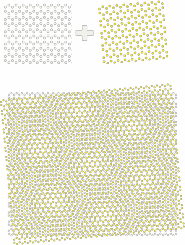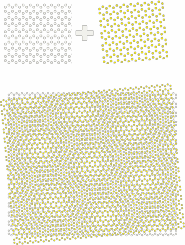
Despite its superlative properties, graphene has not been used to make electronic devices because electrons travel so well though it that they cannot be easily controlled. Now physicists have discovered that placing graphene sheets on boron nitride at the proper angle creates a superlattice that controls the movement of graphene electrons. A hat tip to ScienceDaily for reprinting this University of Arizona news release written by Daniel Stolte “Microprocessors From Pencil Lead“:
Graphite, more commonly known as pencil lead, could become the next big thing in the quest for smaller and less power-hungry electronics.
Resembling chicken wire on a nano scale, graphene – single sheets of graphite – is only one atom thick, making it the world’s thinnest material. Two million graphene sheets stacked up would not be as thick as a credit card.
The tricky part physicists have yet to figure out how to control the flow of electrons through the material, a necessary prerequisite for putting it to work in any type of electronic circuit. Graphene behaves very different than silicon, the material currently used in semiconductors.
Last year, a research team led by UA physicists cleared the first hurdle by identifying boron nitride, a structurally identical but non-conducting material, as a suitable mounting surface for single-atom sheets of graphene. The team also showed that in addition to providing mechanical support, boron nitride improves the electronic properties of graphene by smoothening out fluctuations in the electronic charges.
Now the team found that boron nitride also influences how the electrons travel through the graphene. Published in Nature Physics [abstract], the results open up new ways of controlling the electron flow through graphene.
“If you want to make a transistor for example, you need to be able to stop the flow of electrons,” said Brian LeRoy, an assistant professor in the University of Arizona’s department of physics. “But in graphene, the electrons just keep going. It’s difficult to stop them.” …
However, as LeRoy’s group has now discovered, mounting graphene on boron nitride prevents some of the electrons from passing to the other side, a first step toward a more controlled electron flow.
The group achieved this feat by placing graphene sheets onto boron nitride at certain angles, resulting in the hexagonal structures in both materials to overlap in such a way that secondary, larger hexagonal patterns are created. The researchers call this structure a superlattice.
If the angle is just right, they found, a point is reached where almost no electrons go through.
The news release points out that the researchers cannot yet control the angle at which the graphene and boron nitride are oriented so that only 10-20% of the samples they make show the desired effect. This process must be automated before graphene electronics become practical.
—James Lewis, PhD
